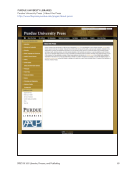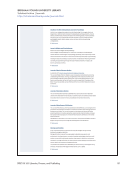57 SPEC Kit 357: Libraries, Presses, and Publishing
recruit authors/users. Assemble a team of people to work on publishing activities—give them clear goals
to work toward. Publishing efforts are difficult to bring to fruition if the necessary resources are not
put in place. That’s why a team needs to be assembled instead of one or two seemingly knowledgeable
people having the whole publishing program placed on their shoulders, and the team needs clear goals
to increase collaboration and effectiveness.
Implement a call for proposals process, with an evaluative component, for making decisions about
selecting publications for development. Form a knowledgeable review committee to determine
workload constraints and seek to implement cost-recovery activities. Publication development activities
nearly always require graphic design efforts and production work. These are services that must be
provided but existing library staff rarely have the skillset required, nor is there enough demand at the
outset to hire staff to perform these functions. Outsourcing this work is necessary, but it is costly and can
be paid for by the stewards of the publications. Create a business plan. Having a clear set of principles, a
well defined scope of work, an operational plan, a budget, and a detailed staffing plan is not only helpful
in communicating within the library but also helps all team members have a shared understanding of
their purpose and function.
Importance of open line of communication and solid working relationship with the graduate school.
Requires recurring financial support. Importance of outreach in order to form campus partnerships and
ability to provide guidance on copyright policy.
It has proven valuable to have a quarterly steering group meeting to help us assess potential new
projects, juggle priorities, and generally keep the leadership team up to speed with the details of our
work so that we could be sure we were aligned with strategic goals and other institutional priorities. We
have worked very hard to build systems and select software that would enable us to create workflows
that are repeatable, scalable, and sustainable over time. It is not always obvious how to do this, but it is
important to keep those criteria in mind as we determine new directions.
It is important to meet faculty on their own terms, to find out what THEY need and develop services
tailored to meeting those needs. Be careful not to overpromise and underdeliver.
It is key that technical staff and librarians work together on library publishing projects. Technical staff
are good at setting systems up. Librarians and technical staff together are good at orienting and training
editorial staff. And librarians are naturally good at getting a new publication properly registered for an
ISSN, pushing its metadata out to the appropriate places, getting its content indexed in the appropriate
bibliographic databases. Start small and make sure there is an actual need for library-based publishing
services. Some proposed new publications are most appropriate for the university press to handle some
are most appropriate for library publishing services to handle. The university press is the EXPERT in
this regard. They should always vet a proposed new publication first.
It’s hard to get faculty attention outreach must be repeated and constant. It’s important to give staff the
resources to be effective this isn’t something that you can just fit in when you have time. It’s important
to have someone to champion a project otherwise, any new initiative can get lost in the shuffle.
It’s slow going. It’s hard to change university culture.
Library and publishing KSAs are complementary, but distinct.
Move from a fragmented, distributed model to a more consolidated approach in order to improve
service. Funding for digitization projects is largely dependent on external, fee-for-service agreements
and donor funding these funding streams mean that digitization projects are reactive, often come with
conditions, timelines are difficult to predict, and ability to target materials/collections for digitization
is limited.
NA. We haven’t yet done enough to learn anything.
recruit authors/users. Assemble a team of people to work on publishing activities—give them clear goals
to work toward. Publishing efforts are difficult to bring to fruition if the necessary resources are not
put in place. That’s why a team needs to be assembled instead of one or two seemingly knowledgeable
people having the whole publishing program placed on their shoulders, and the team needs clear goals
to increase collaboration and effectiveness.
Implement a call for proposals process, with an evaluative component, for making decisions about
selecting publications for development. Form a knowledgeable review committee to determine
workload constraints and seek to implement cost-recovery activities. Publication development activities
nearly always require graphic design efforts and production work. These are services that must be
provided but existing library staff rarely have the skillset required, nor is there enough demand at the
outset to hire staff to perform these functions. Outsourcing this work is necessary, but it is costly and can
be paid for by the stewards of the publications. Create a business plan. Having a clear set of principles, a
well defined scope of work, an operational plan, a budget, and a detailed staffing plan is not only helpful
in communicating within the library but also helps all team members have a shared understanding of
their purpose and function.
Importance of open line of communication and solid working relationship with the graduate school.
Requires recurring financial support. Importance of outreach in order to form campus partnerships and
ability to provide guidance on copyright policy.
It has proven valuable to have a quarterly steering group meeting to help us assess potential new
projects, juggle priorities, and generally keep the leadership team up to speed with the details of our
work so that we could be sure we were aligned with strategic goals and other institutional priorities. We
have worked very hard to build systems and select software that would enable us to create workflows
that are repeatable, scalable, and sustainable over time. It is not always obvious how to do this, but it is
important to keep those criteria in mind as we determine new directions.
It is important to meet faculty on their own terms, to find out what THEY need and develop services
tailored to meeting those needs. Be careful not to overpromise and underdeliver.
It is key that technical staff and librarians work together on library publishing projects. Technical staff
are good at setting systems up. Librarians and technical staff together are good at orienting and training
editorial staff. And librarians are naturally good at getting a new publication properly registered for an
ISSN, pushing its metadata out to the appropriate places, getting its content indexed in the appropriate
bibliographic databases. Start small and make sure there is an actual need for library-based publishing
services. Some proposed new publications are most appropriate for the university press to handle some
are most appropriate for library publishing services to handle. The university press is the EXPERT in
this regard. They should always vet a proposed new publication first.
It’s hard to get faculty attention outreach must be repeated and constant. It’s important to give staff the
resources to be effective this isn’t something that you can just fit in when you have time. It’s important
to have someone to champion a project otherwise, any new initiative can get lost in the shuffle.
It’s slow going. It’s hard to change university culture.
Library and publishing KSAs are complementary, but distinct.
Move from a fragmented, distributed model to a more consolidated approach in order to improve
service. Funding for digitization projects is largely dependent on external, fee-for-service agreements
and donor funding these funding streams mean that digitization projects are reactive, often come with
conditions, timelines are difficult to predict, and ability to target materials/collections for digitization
is limited.
NA. We haven’t yet done enough to learn anything.



















































































































































































